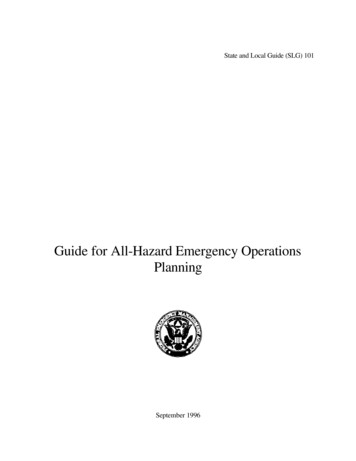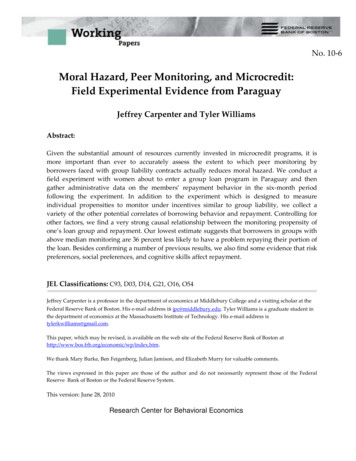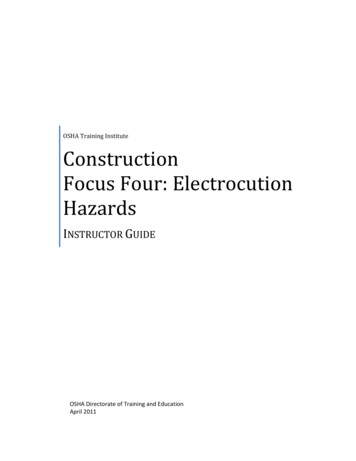
Transcription
State and Local Guide (SLG) 101Guide for All-Hazard Emergency OperationsPlanningSeptember 1996
FOREWORDOne goal of the Federal Emergency Management Agency (FEMA) is to develop, in partnership withState and local governments, a national emergency management system that is comprehensive, riskbased, and all-hazard in approach.Crucial to this system are emergency operations plans (EOP), which describe who will do what, as wellas when, with what resources, and by what authority--before, during, and immediately after anemergency.This State and Local Guide (SLG) provides emergency managers and other emergency servicespersonnel with information on FEMA's concept for developing risk-based, all-hazard emergencyoperations plans.This Guide clarifies the preparedness, response, and short-term recovery planning elements that warrantinclusion in State and local EOPs. It offers FEMA's best judgment and recommendations on how todeal with the entire planning process--from forming a planning team to writing the plan. It alsoencourages emergency managers to address all of the hazards that threaten their jurisdiction in a singleEOP instead of relying on stand-alone plans.This Guide should help State and local emergency management organizations produce EOPs that: serve as the basis for effective response to any hazard that threatens the jurisdiction; facilitate integration of mitigation into response and recovery activities; and facilitate coordination with the Federal Government during catastrophic disastersituations that necessitate implementation of the Federal Response Plan (FRP).Emergency planners in the business and industry and animal care communities may find portions of thisGuide useful in the development of their emergency response plans. Industry planners may also consultFEMA-141, Emergency Management Guide for Business and Industry.FEMA welcomes recommendations on how this Guide can be improved to better serve the needs ofthe emergency management community. Comments should be addressed to FEMA, Attn:Preparedness, Training, and Exercises Directorate, State and Local Preparedness Division,Washington, DC 20472.Kay C. GossAssociate Director for Preparedness,
Training, and Exercises
page iiBLANK PAGESLG 101: Guide for All-Hazard Emergency Operations Planning(9/96)
page iiiAbout This DocumentPurposeThis Guide is meant to aid State and local emergency managers (also called"emergency management coordinators") in their efforts to develop and maintaina viable all-hazard emergency operations plan. The Guide is a "toolbox" ofideas and advice, not a sample EOP. Each community's EOP must reflectwhat that community will do to protect itself from its hazards with theresources it has or can obtain.Applicabilityand ScopeThis Guide is intended primarily for use by personnel responsible for EOPdevelopment and maintenance in State and local emergency managementagencies. It is strictly a guide. It establishes no requirements, and itsrecommendations may be used, adapted, or disregarded.SupersessionThis SLG is new. It replaces Civil Preparedness Guide (CPG) 1-8, Guide forthe Development of State and Local Emergency Operations Plans (datedSeptember 10, 1990); CPG 1-8A, Guide for the Review of State and LocalEmergency Operations Plans, (dated October 1992); and CPG 1-10, Guidefor the Development of a State and Local Continuity of GovernmentCapability (dated July 27, 1987), which have been rescinded.AuthoritiesThis SLG is issued under authority of the Robert T. Stafford Disaster Reliefand Emergency Assistance Act, as amended. In this law, Congressrecognizes emergency management as a joint responsibility of Federal, State,and local government. For the Federal Government, Congress defines a rolethat includes providing "necessary direction, coordination, and guidance" (Sec.601) for the Nation's emergency management system, to include "technicalassistance to the States in developing comprehensive plans and programs forpreparation against disasters" (para. 201(b)).Local governments should use this Guide to supplement guidance from theirStates.Overview ofContentsChapter 1 explains what an EOP is at the State and local levels, why the EOP isa necessary part of a comprehensive approach to emergency management, andhow the EOP relates to other aspects of the comprehensive, risk-based, allhazard approach.SLG 101: Guide for All-Hazard Emergency Operations Planning(9/96)
page ivChapter 2 describes the approach FEMA recommends for a step-by-stepprocess of risk-based, all-hazard emergency operations planning. Chapter 3suggests how to format the results of the planning process in a written EOP.Chapters 4 and 5 list and discuss elements that, if applicable for a jurisdiction,should be addressed in its all-hazard EOP.Chapter 6 notes unique aspects of certain hazards, including associatedregulatory requirements. It suggests how to address these unique aspects in theall-hazard EOP rather than in stand-alone plans. The chapter is not meant toreplace hazard-specific planning guidance issued by the Radiological EmergencyPreparedness (REP) Program of FEMA and the Nuclear RegulatoryCommission (NRC), the Chemical Stockpile Emergency PreparednessProgram (CSEPP), or the National Response Team (NRT).Chapter 7 contains information on integrating State EOPs with the FederalResponse Plan, so that all levels of government can provide a coordinatedresponse to communities in need.Please note that, unlike previous FEMA planning guidance, this Guideaddresses animal care and control and gives extensive treatment to resourcemanagement (including donations management).RevisionProcessTo be relevant, FEMA's planning guidance had to reflect three basic changes:(1) Congress eliminated emphasis on the nuclear attack hazard and restatedFederal Civil Defense Act authorities in the Stafford Act; (2) FEMA and theFederal Government have acquired a broader role in disaster response; and (3)emergency management planning in the States and many localities has maturedbeyond the sample plans FEMA provided in earlier planning guidance. Also,FEMA has taken a new approach to dealing with the States: PerformancePartnership Agreements (PPA). With Performance Partnership Agreements,FEMA trades increased flexibility "up front" for increased attention to results.This Guide fits the new way of doing business.In July 1995, FEMA convened a group of local, State, and Regional plannersto offer suggestions on making all-hazard EOP guidance more useful given"conditions in the field." This Guide reflects many of their ideas.FEMA will revise this SLG as needed. Change pages will be issued through theSLG 101: Guide for All-Hazard Emergency Operations Planning(9/96)
page ivFEMA publication distribution system to organizations designated to receive thisGuide. Other holders of this document should contact their State or localemergency management organization or the FEMA Printing and PublicationsBranch to get a copy of the change(s) or more copies of the Guide.SLG 101: Guide for All-Hazard Emergency Operations Planning(9/96)
page vTable of ContentsPageForeword .iAbout this DocumentPurpose .iiiApplicability and Scope.iiiSupersession.iiiAuthorities .iiiOverview of Contents .iiiRevision Process.ivList of Figures and Tables.ixChapter 1 - Preliminary ConsiderationsWhat an EOP is .1-1GeneralLocal EOPsState EOPsWhy Your Jurisdiction Should Have an EOP .1-2Government's Responsibility for Emergency ManagementComprehensive Emergency ManagementCriticality of All-Hazard EOPsWhat an EOP is Not .1-5Other Types of PlansPlans Versus ProceduresChapter 2 - The Planning ProcessIntroduction.2-1Principles.2-1Don't Reinvent the WheelDon't Go It AloneDon't Forget the Chief Executive Official (“CEO”)Steps .2-4ResearchSLG 101: Guide for All-Hazard Emergency Operations Planning(9/96)
page vDevelopmentValidationMaintenancePageChapter 3 - Emergency Operations Plan FormatIntroduction.3-1A Functional Approach to the Overall Structure of the EOP.3-2ConceptComponentsOptionsA Task-Based Approach to Each Section of the EOP .3-3ConceptComponentsOptionsChapter 4 - Basic Plan ContentIntroduction.4-1Elements of the Basic Plan.4-1Introductory MaterialPurposeSituation and AssumptionsConcept of OperationsOrganization and Assignment of ResponsibilitiesAdministration and LogisticsPlan Development and MaintenanceAuthorities and ReferencesChapter 5 - Functional Annex ContentContent.5-1Functions To Include as Annexes.5-1Description of Core Functions .5-2Attachment A - Direction and Control.5-A-1Attachment B - Communications .5-B-1Attachment C - Warning .5-C-1Attachment D - Emergency Public Information.5-D-1SLG 101: Guide for All-Hazard Emergency Operations Planning(9/96)
Table of Contentspage viAttachment E - Evacuation.5-E-1Attachment F - Mass Care.5-F-1Attachment G - Health and Medical.5-G-1Attachment H - Resource Management .5-H-1PageChapter 6 - Hazard-Unique Planning ConsiderationsIntroduction .6-1Development of a Hazard-Specific Appendix.6-1Content of A Hazard-Specific Appendix.6-2Description of Unique and Regulatory Planning Considerations.6-3Attachment A - Earthquake.6-A-1Attachment B - Flood/Dam Failure.6-B-1Attachment C - Hazardous Materials.6-C-1Attachment D - Hurricane .6-D-1Attachment E - Lethal Unitary Chemical Agents and Munitions.6-E-1Attachment F - Radiological Hazards.6-F-1Attachment G - Terrorism.to be developed .6-G-1Attachment H - Tornado .6-H-1Chapter 7 - Linking Federal and State Emergency Response OperationsIntroduction.7-1Relationship - Federal (National and Regional) Response Plans and the State EOP.7-1Glossary of Terms.GLO-1List of Acronyms.ACR-1Bibliography.BIB-1SLG 101: Guide for All-Hazard Emergency Operations Planning(9/96)
page viiiBLANK PAGESLG 101: Guide for All-Hazard Emergency Operations Planning(9/96)
page ixList of Figures and TablesPageTable 4-1:Figure 5-D-1:Figure 5-H-1:Table 6-1:Table 6-D-1:Figure 7-1:Table 7-1:Organizational Responsibilities for Response Functions.4-5Possible Components of an EPI Organization.5-D-11Possible Components of a Resource Management Organization.5-H-10Typical Content of Hazard-Specific Appendices to Core Functional Annexes.6-3Generic Damage Characteristics of Hurricanes.6-D-9Emergency Response Coordinating Roles in Large-Scale Disasters .7-2Functional Relationships .7-8SLG 101: Guide for All-Hazard Emergency Operations Planning(9/96)
page xBLANK PAGESLG 101: Guide for All-Hazard Emergency Operations Planning(9/96)
page 1-1Chapter 1Preliminary ConsiderationsWhat an EOP IsGeneralA jurisdiction's emergency operations plan is a document that:ØAssigns responsibility to organizations and individuals for carrying outspecific actions at projected times and places in an emergency thatexceeds the capability or routine responsibility of any one agency, e.g.,the fire department.ØSets forth lines of authority and organizational relationships, and showshow all actions will be coordinated.ØDescribes how people and property will be protected in emergenciesand disasters.ØIdentifies personnel, equipment, facilities, supplies, and other resourcesavailable--within the jurisdiction or by agreement with otherjurisdictions--for use during response and recovery operations.ØIdentifies steps to address mitigation concerns during response andrecovery activities.As a public document, an EOP also cites its legal basis, states its objectives,and acknowledges assumptions.Local EOPsIn our country's system of emergency management, local government must actfirst to attend to the public’s emergency needs. Depending on the nature andsize of the emergency, State and Federal assistance may be provided to thelocal jurisdiction. The local EOP focuses on the measures that are essential forprotecting the public. These include warning, emergency public information,evacuation, and shelter.State EOPsStates play three roles: They assist local jurisdictions whose capabilities areoverwhelmed by an emergency; they themselves respond first to certainSLG 101: Guide for All-Hazard Emergency Operations Planning(9/96)
Chapter 1: Preliminary Considerationspage 1-2emergencies; and they work with the Federal Government when Federalassistance is necessary. The State EOP is the framework within which localEOPs are created and through which the Federal Government becomesinvolved. As such, the State EOP ensures that all levels of government areable to mobilize as a unified emergency organization to safeguard the well-beingof State citizens. The State EOP is of critical importance.Why Your Jurisdiction Should Have an EOPGovernment'sResponsibilityfor EmergencyManagementWhen disasters threaten or strike a jurisdiction, people expect elected leadersto take immediate action to deal with the problem. The government is expectedto marshal its resources, channel the efforts of voluntary agencies and privateenterprise in the community, and solicit assistance from outside of thejurisdiction if necessary.In all States and most localities, that popular expectation is given force bystatute or ordinance. Congress also recognizes State and local emergencymanagement responsibility in the Robert T. Stafford Disaster Relief andEmergency Assistance Act, as amended:Ø"It is the intent of Congress, by this Act, to provide an orderly andcontinuing means of assistance by the Federal Government to State andlocal governments in carrying out their responsibilities to alleviate thesuffering and damage which result from [.] disasters (Sec. 101(b),emphasis added).Ø"The purpose of this title is [.] to vest responsibility for emergencypreparedness jointly in the Federal Government and the several Statesand their political subdivisions" (Sec. 601).The elected leadership in each jurisdiction is legally responsible for ensuring thatnecessary and appropriate actions are taken to protect people and propertyfrom the consequences of emergencies and nts can discharge their emergency management responsibilities bytaking four interrelated actions: mitigation, preparedness, response, andrecovery. A systematic approach is to treat each action as one phase of acomprehensive process, with each phase building on the accomplishments of thepreceding one. The overall goal is to minimize the impact caused by anSLG 101: Guide for All-Hazard Emergency Operations Planning(9/96)
Chapter 1: Preliminary Considerationspage 1-3emergency in the jurisdiction.MitigationMitigation actions involve lasting, often permanent, reduction of exposure to,probability of, or potential loss from hazard events. They tend to focus onwhere and how to build. Examples include: zoning and building coderequirements for rebuilding in high-hazard areas; floodplain buyouts; andanalyses of floodplain and other hazard-related data to determine where it issafe to build in normal times, to open shelters in emergencies, or to locatetemporary housing in the aftermath of a disaster. Mitigation also can involveeducating businesses and the public on simple measures they can take to reduceloss and injury, like fastening bookshelves, water heaters, and file cabinets towalls to keep them from falling during earthquakes.Cost-effective mitigation measures are the key to reducing disaster losses in thelong term. In hazard-prone areas, mitigation can break the cycle of having torebuild and rebuild again with every recurrence of floods, hurricanes, orearthquakes. Where there is a willingness to mitigate, opportunities can befound. Ongoing efforts might include: educating the private sector about what itcan do to mitigate at home and at work; reaching out to planning, zoning, anddevelopment agencies to ensure that hazard conditions are considered incomprehensive plans, construction permits, building codes, design approvals,etc.; and creating inventories of existing structures and their vulnerabilities, to aidmitigation planning. There is also a need for planning to take advantage ofmitigation opportunities in the aftermath of an emergency or disaster, whenhazard awareness is high, funds may become available (with associatedrequirements for mitigation), and disruption of the status quo makes it possibleto rethink design and location of some facilities and infrastructure. Attention tomitigation opportunities can make safer communities for us all.PreparednessWhile mitigation can make communities safer, it does not eliminate risk andvulnerability for all hazards. Therefore, jurisdictions must be ready to faceemergency threats that have not been mitigated away. Since emergencies oftenevolve rapidly and become too complex for effective improvisation, agovernment can successfully discharge its emergency managementresponsibilities only by taking certain actions beforehand. This is preparedness.Preparedness involves establishing authorities and responsibilities for emergencyactions and garnering the resources to support them: a jurisdiction must assignSLG 101: Guide for All-Hazard Emergency Operations Planning(9/96)
Chapter 1: Preliminary Considerationspage 1-4or recruit staff for emergency management duties and designate or procurefacilities, equipment, and other resources for carrying out assigned duties. Thisinvestment in emergency management requires upkeep: the staff must receivetraining and the facilities and equipment must be maintained in working order.To ensure that the jurisdiction's investment in emergency managementpersonnel and resources can be relied upon when needed, there must be aprogram of tests, drills, and exercises. Consideration also must be given toreducing or eliminating the vulnerability of the jurisdiction’s emergencyresponse organizations and resources to the hazards that threaten thejurisdiction.Accordingly, preparedness measures should not be improvised or handled onan ad hoc basis. A key element of preparedness is the development of plansthat link the many aspects of a jurisdiction's commitment to emergencymanagement.ResponseThe onset of an emergency creates a need for time-sensitive actions to savelives and property, as well as for action to begin stabilizing the situation so thatthe jurisdiction can regroup. Such response actions include notifying emergencymanagement personnel of the crisis, warning and evacuating or sheltering thepopulation if possible, keeping the population informed, rescuing individuals andproviding medical treatment, maintaining the rule of law, assessing damage,addressing mitigation issues that arise from response activities, and evenrequesting help from outside the jurisdiction.RecoveryRecovery is the effort to restore infrastructure and the social and economic lifeof a community to normal, but it should incorporate mitigation as a goal. Forthe short term, recovery may mean bringing necessary lifeline systems (e.g.,power, communication, water and sewage, and transportation) up to anacceptable standard while providing for basic human needs (e.g., food, clothing,and shelter) and ensuring that the societal needs of individuals and thecommunity are met (e.g., maintain the rule of law, provide crisis counseling,demonstrate that people do care and that help is becoming available). Oncesome stability is achieved, the jurisdiction can begin recovery efforts for the longterm, restoring economic activity and rebuilding community facilities and familyhousing with attention to long-term mitigation needs.Criticality ofAll-HazardThe centerpiece of comprehensive emergency management is the EOP. First,the EOP defines the scope of preparedness activity necessary to make theSLG 101: Guide for All-Hazard Emergency Operations Planning(9/96)
Chapter 1: Preliminary ConsiderationsEOPspage 1-5EOP more than a mere paper plan. Training and exercises, in particular, dependon an EOP. Training helps emergency response personnel to become familiarwith their responsibilities and to acquire the skills necessary to perform assignedtasks. Exercising provides a means to validate plans, checklists, and responseprocedures and to evaluate the skills of response personnel.Second, the EOP facilitates response and short-term recovery (which set thestage for successful long-term recovery). Response actions are time-sensitive,with little allowance for delay or "mid-course corrections,” and some postdisaster mitigation issues such as rebuilding and placement of temporary housingfacilities also must be addressed quickly. Advance planning makes this easier.Finally, an EOP that is flexible enough for use in all emergencies--includingunforeseen events--provides a community with an emergency management"bottom line." From there, a community can proceed confidently with long-termmitigation efforts directed at specific hazards. Or, it can devote moreresources to risk-based preparedness measures (e.g., specialized training,equipment, and planning). Whatever the initiative, an all-hazard EOP helps thecommunity start from a position of relative security.What an EOP Is NotThose who draft an EOP must understand what it is not. While this chapter hascalled a jurisdiction's EOP--its response plan--the "centerpiece" of itscomprehensive emergency management effort, that does not mean that the EOPdetails all aspects of that effort.Other Typesof PlansEmergency management involves several kinds of plans, just as it involvesseveral kinds of actions.AdministrativePlansAdministrative plans describe policies and procedures basic to the support of agovernmental endeavor: typically they deal less with external work productsthan with internal processes. Examples include plans for financial management,personnel management, records review, and labor relations activities. Suchplans are not the direct concern of an EOP. However, if it is assumed thatprovisions of an administrative plan apply in emergency situations, then theadministrative plan may be referenced in the EOP. Likewise, if exceptions tonormal administrative plans are permitted in an emergency, that fact should beSLG 101: Guide for All-Hazard Emergency Operations Planning(9/96)
Chapter 1: Preliminary Considerationspage 1-5noted in the relevant part of the EOP.MitigationPlansA jurisdiction may outline its strategy for mitigating the hazards it faces; in fact, amitigation plan is required of States that seek funds for post-event mitigationafter Presidential declarations under the Stafford Act. Existing plans formitigating hazards are relevant to an EOP, particularly in short-term recoverydecision-making, which can affect prospects for effective implementation of amitigation strategy aimed at reducing the long-term risk to human life andproperty in the jurisdiction.PreparednessPlansPreparedness planning covers three objectives: maintaining existing emergencymanagement capability in readiness; preventing emergency managementcapabilities from themselves falling victim to emergencies; and, if possible,augmenting the jurisdiction's emergency management capability.Such plans would include: the process and schedule for identifying and meetingtraining needs (based on expectations created by the EOP); the process andschedule for developing, conducting, and evaluating exercises, and correctingidentified deficiencies; and plans to procure or build facilities and equipment thatcan withstand the effects of hazards facing the jurisdiction. Results of theseefforts should be incorporated in the EOP as assumptions: that certainequipment and facilities are available, that people are trained and exercised, etc.Operational checks of equipment and communications systems, however, be apart of each tasked organization’s standard operating procedures (SOP) for theperiod between notification and impact of an emergency. Measures tosafeguard emergency management personnel, as well as vital records andexisting equipment, should be part of an EOP.RecoveryPlansTypically, an EOP does not spell out recovery actions beyond rapid damageassessment and the actions necessary to satisfy the immediate life support needsof disaster victims; the EOP should provide for a transition to a recovery plan, ifany exists, and for a stand-down of response forces. However, some shortterm recovery actions are natural extensions of response and are covered by theEOP. For example, meeting human needs would require maintaining logisticalsupport to mass care actions initiated in the response phase, with the addition ofcrisis counseling; it would also involve restoration of infrastructure "lifelines," andSLG 1-XX: Guide for All-Hazard Emergency Operations Planning(3/96)
Chapter 1: Preliminary Considerationspage 1-7perhaps debris removal to facilitate response. At the State's discretion, itsdisaster assistance plans for distribution of Federal and State relief funds may beannexed to the EOP. Disaster assistance plans would identify how eligible aidrecipients will be identified, contacted, matched to aid, certified, and issuedchecks.Plans VersusProceduresBeyond that lies long-term recovery, which is not strictly time-sensitive and cansometimes be more ad hoc. Pre-disaster planning for long-term mitigation andrecovery would involve identifying strategic priorities for restoration,improvement, and growth; here emergency management planning starts tointersect the community development planning of other agencies. FEMArecommends and supports the development of State and local hazard mitigationplans to facilitate and expedite obtaining Federal mitigation funds during thepost-disaster recovery period.Although the distinction between plans and procedures is fluid, writers of anEOP should use it to keep the EOP free of unnecessary detail. The basiccriterion is: What does the entire audience of this part of the EOP need toknow, or have set out as a matter of public record? Information and "how-to"
SLG 101: Guide for All-Hazard Emergency Operations Planning (9/96) About This Document Purpose This Guide is meant to aid State and local emergency managers (also called "emergency management coordinators") in their efforts to develop and maintain a viable all-hazard emergency operations










